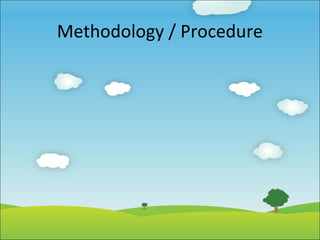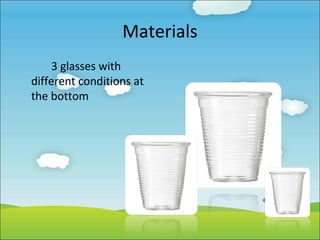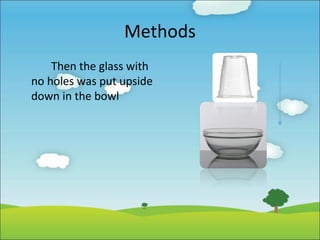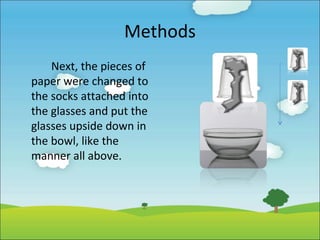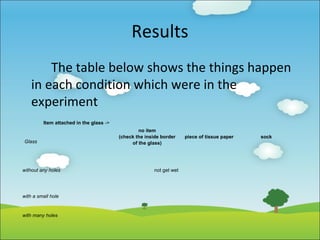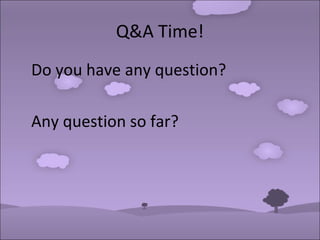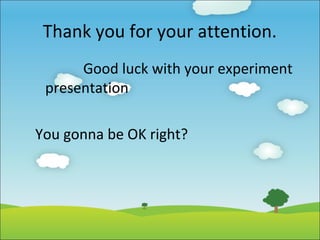Will the tissue get wet? Mini-science experiment
- 1. Will the Tissue Paper get wet? Experiment presentation Mr.Naruedol Bongkotkarn Mr.Mean Sriwilairit
- 2. Introduction The aim of the experiment is to show if various materials will get wet or not when we do this experiment and to prove some kind of theory about the air.
- 3. Literature Review Air is matter (Otto Von Guericke, 1654). Matter is anything that has mass and takes up space.
- 4. Literature Review To prove that air takes up space or not, several discussion have been made, for example: 1. Steve Gagnon (n.d.) studied about the balloons inflating and balloons disturbing which can prove that air takes up space also. 2. Many scientist (n.d.) says a common way of defining matter is as anything that has mass and occupies volume.
- 5. Literature Review In this experiment, we chose the basic way that can prove like this also and easy to get the results.
- 7. Materials The materials needed were a bowl of water, a glass with no holes, a glass with a small hole, a glass with many holes at the bottom, pieces of tissue paper, and socks.
- 8. Materials 3 glasses with different conditions at the bottom
- 10. Materials Socks
- 12. Methods First, the water was filled in the bowl.
- 13. Methods Then the glass with no holes was put upside down in the bowl
- 14. Methods Then the glass with no holes was put upside down in the bowl, the glasses with holes at the bottom were placed in the same manner.
- 15. Methods After that, a piece of paper was attached into the glass with no holes and the glass was put upside down in the bowl
- 16. Methods After that, a piece of paper was attached into the glass with no holes and the glass was put upside down in the bowl, the glasses with holes at the bottom which had a piece of paper attached into the glass were placed in the same manner.
- 17. Methods Next, the pieces of paper were changed to the socks attached into the glasses and put the glasses upside down in the bowl, like the manner all above.
- 18. Measurement Observed the results to find out which materials get wet or not.
- 19. Results The table below shows the things happen in each condition which were in the experiment
- 20. Results The table below shows the things happen in each condition which were in the experiment Glass without any holes with a small hole with many holes .
- 21. Results The table below shows the things happen in each condition which were in the experiment Item attached in the glass -> Glass without any holes with a small hole with many holes . no item (check the inside border of the glass) piece of tissue paper sock
- 22. Results The table below shows the things happen in each condition which were in the experiment Item attached in the glass -> Glass without any holes with a small hole with many holes . no item (check the inside border of the glass) not get wet piece of tissue paper sock
- 23. Results The table below shows the things happen in each condition which were in the experiment Item attached in the glass -> Glass without any holes with a small hole with many holes . no item (check the inside border of the glass) not get wet piece of tissue paper not get wet sock
- 24. Results The table below shows the things happen in each condition which were in the experiment Item attached in the glass -> Glass without any holes with a small hole with many holes . no item (check the inside border of the glass) not get wet piece of tissue paper not get wet sock get wet only the remaining part out from the glass
- 25. Results The table below shows the things happen in each condition which were in the experiment Item attached in the glass -> Glass without any holes with a small hole with many holes . no item (check the inside border of the glass) piece of tissue paper sock not get wet not get wet get wet only the remaining part out from the glass wet patiently wet patiently wet patiently
- 26. Results The table below shows the things happen in each condition which were in the experiment Item attached in the glass -> Glass . no item (check the inside border of the glass) piece of tissue paper sock not get wet not get wet get wet only the remaining part out from the glass with a small hole wet patiently wet patiently wet patiently with many holes wet immediately wet immediately wet immediately without any holes
- 27. Results From the table, we can see that if we use the glass with hole(s), the materials will sure get wet. The materials in the glass with a small hole will get slower than one with many holes which will make materials get wet immediately. While the glass without any holes will not make the materials get wet inside. However if there’s some remaining part of the materials like some part of the socks out of the glass, that part will sure get wet but the part inside the glass will not get wet.
- 28. Conclusion It can be concluded that if there is no holes at the bottom of the glass, the air cannot go up out because there’s no way higher that the air can exit and the air will take space in the glass preventing the water from making the materials attached inside the glass get wet.
- 29. Conclusion While the glasses with holes will sure make the materials get wet because there are holes to let the air go up out from the glass so water can take spaces in the glass replace the air spaces and make materials get wet, slow or fast depending on the size of the holes area. Therefore, air takes up space.
- 30. Conclusion Do you believe there is some air even in the underwater?
- 31. Q&A Time! Do you have any question? Any question so far?
- 32. Sources Olesik S. (1999). WOW Project. Ohio State University WOW Project. (n.d.) Air Takes Up Space – Tissue in a Cup. Retrieved July 1, 2010, from http://wow.osu.edu/experiments/gases/tissue.html
- 33. Thank you for your attention. Good luck with your experiment presentation You gonna be OK right?






